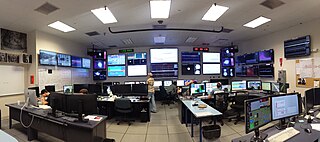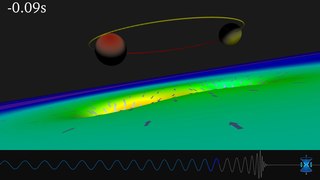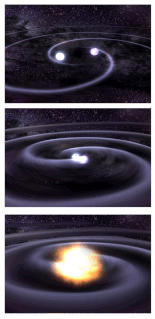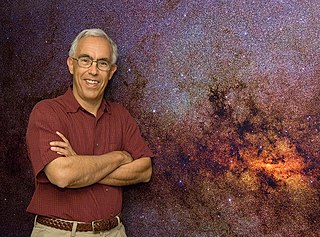
The Laser Interferometer Gravitational-Wave Observatory (LIGO) is a large-scale physics experiment and observatory to detect cosmic gravitational waves and to develop gravitational-wave observations as an astronomical tool. Two large observatories were built in the United States with the aim of detecting gravitational waves by laser interferometry. These can detect a change in the 4 km mirror spacing of less than a ten-thousandth the charge diameter of a proton.

Rainer "Rai" Weiss is an American physicist, known for his contributions in gravitational physics and astrophysics. He is a professor of physics emeritus at MIT and an adjunct professor at LSU. He is best known for inventing the laser interferometric technique which is the basic operation of LIGO. He was Chair of the COBE Science Working Group.

GEO600 is a gravitational wave detector located near Sarstedt in the South of Hanover, Germany. It is designed and operated by scientists from the Max Planck Institute for Gravitational Physics, Max Planck Institute of Quantum Optics and the Leibniz Universität Hannover, along with University of Glasgow, University of Birmingham and Cardiff University in the United Kingdom, and is funded by the Max Planck Society and the Science and Technology Facilities Council (STFC). GEO600 is part of a worldwide network of gravitational wave detectors. This instrument, and its sister interferometric detectors, when operational, are some of the most sensitive gravitational wave detectors ever designed. They are designed to detect relative changes in distance of the order of 10−21, about the size of a single atom compared to the distance from the Sun to the Earth. GEO600 is capable of detecting gravitational waves in the frequency range 50 Hz to 1.5 kHz. Construction on the project began in 1995.

The Kamioka Gravitational Wave Detector (KAGRA), formerly the Large Scale Cryogenic Gravitational Wave Telescope (LCGT), is a project of the gravitational wave studies group at the Institute for Cosmic Ray Research (ICRR) of the University of Tokyo. It is the world's first gravitational wave observatory in Asia, the first built underground, and the first whose detector uses cryogenic mirrors. The design calls for an operational sensitivity equal to, or greater, than LIGO.
The Kamioka Observatory, Institute for Cosmic Ray Research is a neutrino and gravitational waves laboratory located underground in the Mozumi Mine of the Kamioka Mining and Smelting Co. near the Kamioka section of the city of Hida in Gifu Prefecture, Japan. A set of groundbreaking neutrino experiments have taken place at the observatory over the past two decades. All of the experiments have been very large and have contributed substantially to the advancement of particle physics, in particular to the study of neutrino astronomy and neutrino oscillation.

The Virgo interferometer is a large interferometer designed to detect gravitational waves predicted by the general theory of relativity. Virgo is a Michelson interferometer that is isolated from external disturbances: its mirrors and instrumentation are suspended and its laser beam operates in a vacuum. The instrument's two arms are three kilometres long and located in Santo Stefano a Macerata, near the city of Pisa, Italy.
Astroparticle physics, also called particle astrophysics, is a branch of particle physics that studies elementary particles of astronomical origin and their relation to astrophysics and cosmology. It is a relatively new field of research emerging at the intersection of particle physics, astronomy, astrophysics, detector physics, relativity, solid state physics, and cosmology. Partly motivated by the discovery of neutrino oscillation, the field has undergone rapid development, both theoretically and experimentally, since the early 2000s.

Gravitational waves are disturbances in the curvature of spacetime, generated by accelerated masses, that propagate as waves outward from their source at the speed of light. They were proposed by Henri Poincaré in 1905 and subsequently predicted in 1916 by Albert Einstein on the basis of his general theory of relativity. Gravitational waves transport energy as gravitational radiation, a form of radiant energy similar to electromagnetic radiation. Newton's law of universal gravitation, part of classical mechanics, does not provide for their existence, since that law is predicated on the assumption that physical interactions propagate instantaneously – showing one of the ways the methods of classical physics are unable to explain phenomena associated with relativity.

A gravitational-wave observatory is any device designed to measure gravitational waves, tiny distortions of spacetime that were first predicted by Einstein in 1916. Gravitational waves are perturbations in the theoretical curvature of spacetime caused by accelerated masses. The existence of gravitational radiation is a specific prediction of general relativity, but is a feature of all theories of gravity that obey special relativity. Since the 1960s, gravitational-wave detectors have been built and constantly improved. The present-day generation of resonant mass antennas and laser interferometers has reached the necessary sensitivity to detect gravitational waves from sources in the Milky Way. Gravitational-wave observatories are the primary tool of gravitational-wave astronomy.

Gravitational-wave astronomy is an emerging branch of observational astronomy which aims to use gravitational waves to collect observational data about objects such as neutron stars and black holes, events such as supernovae, and processes including those of the early universe shortly after the Big Bang.
The Australian International Gravitational Observatory (AIGO) is a research facility located near Gingin, north of Perth in Western Australia. It is part of a worldwide effort to directly detect gravitational waves. Note that these are a major prediction of the general theory of relativity and are not to be confused with gravity waves, a phenomenon studied in fluid mechanics.
The Institute for Cosmic Ray Research (ICRR) of the University of Tokyo was established in 1976 for the study of cosmic rays.
An interferometric gravitational-wave detector is a gravitational wave detector that uses the wave interference to detect gravitational waves. Laser interferometers detects gravitational waves that extend and contract the distance between mirrors. Atom interferometers are proposed to detect gravitational waves, which would lengthen or shorten the distance between recombining atom clouds. Interferometric gravitational-wave detectors are one class of detectors and for more information about other types of instruments used for gravitational wave detection see the article on gravitational wave observatories.
CLIO is the Cryogenic Laser Interferometer Observatory, a prototype detector for gravitational waves. It is testing cryogenic mirror technologies for the future Kamioka Gravitational Wave Detector (KAGRA). It is located in Japan.
Einstein Telescope (ET) or Einstein Observatory, is a proposed third-generation ground-based gravitational wave detector, currently under study by some institutions in the European Union. It will be able to test Einstein's general theory of relativity in strong field conditions and realize precision gravitational wave astronomy.
The Deci-Hertz Interferometer Gravitational wave Observatory is a proposed Japanese, space-based, gravitational wave observatory. The laser interferometric gravitational wave detector is so named because it is to be most sensitive in the frequency band between 0.1 and 10 Hz, filling in the gap between the sensitive bands of LIGO and LISA. If funding can be found, its designers hope to launch it in 2027.
The International Pulsar Timing Array (IPTA) is a multi-institutional, multi-telescope collaboration, comprising the European Pulsar Timing Array (EPTA), the North American Nanohertz Observatory for Gravitational Waves (NANOGrav), and the Parkes Pulsar Timing Array (PPTA). The goal of the IPTA is to detect gravitational waves using an array of approximately 30 pulsars. This goal is shared by each of the participating institutions, but they have all recognized that their goal will be achieved more quickly in collaboration, and by combining their respective resources.

Dr. Thomas A. Prince is the Ira S. Bowen Professor of Physics at the California Institute of Technology and holds a joint appointment with Caltech’s NASA Jet Propulsion Laboratory (JPL) as a Senior Research Scientist. Between May 2001 and June 2006, Prince was the Chief Scientist at JPL. He is currently the Director and Allen V.C. Davis and Lenabelle Davis Leadership Chair for the W. M. Keck Institute for Space Studies at Caltech.

Takaaki Kajita is a Japanese physicist, known for neutrino experiments at the Kamiokande and its successor, Super-Kamiokande. In 2015, he was awarded the Nobel Prize in Physics jointly with Canadian physicist Arthur B. McDonald.











